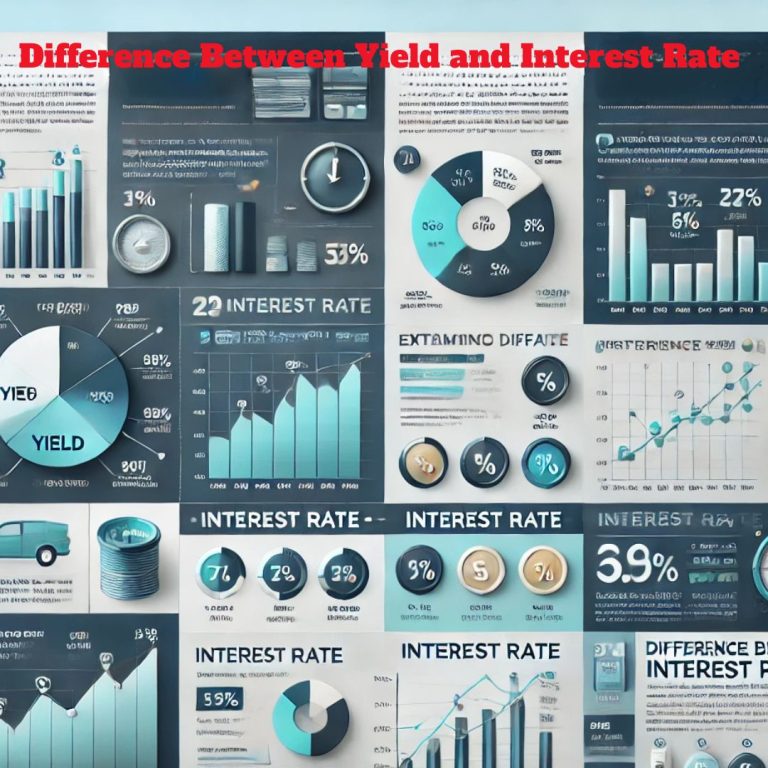The difference between yield and interest rate is a crucial concept in finance, especially when it comes to investments and loans. While both terms are related to the return on investment or cost of borrowing, they have distinct meanings. Interest rate generally refers to the fixed percentage that a lender charges a borrower for using their money, while yield is the total return on an investment over a specific period, including interest payments, dividends, or capital gains. Understanding the difference between yield and interest rate can help investors make more informed decisions and optimize their financial portfolios.
Understanding Yield vs. Interest Rate: Key Definitions and Concepts
To understand the difference between yield and interest rate, it’s important to define each term clearly.
- Interest Rate: An interest rate is the percentage charged by a lender to a borrower for the use of money, typically expressed on an annual basis. This rate is determined by various factors, such as inflation, central bank policies, and the risk associated with lending. In the context of loans, the interest rate is a fixed amount or a variable rate that lenders use to calculate the cost of borrowing.
- Example: If you take out a $1,000 loan with an interest rate of 5%, you would pay $50 annually as the cost of borrowing.
- Yield: Yield, on the other hand, refers to the earnings generated from an investment over a specified period, expressed as a percentage of the investment’s current price or market value. Yield can come from interest payments, dividends, and capital gains. For example, the yield on a bond or stock represents the return an investor can expect to receive from that particular investment.
- Example: If you invest in a bond for $1,000, and it pays you $50 in interest annually, the yield is 5% ($50 ÷ $1,000 = 5%).
Key Points
- Interest rate typically applies to borrowing and lending, while yield applies to investments.
- Interest rate is a fixed cost, while yield reflects the return on an investment.
- Yield includes more than just interest—it may incorporate dividends and capital gains.
How Yield and Interest Rate Impact Investment Decisions?
Both yield and interest rate play a significant role in shaping investment decisions, but they impact investors differently.
- Impact of Interest Rate on Investments: When interest rates rise, the cost of borrowing increases. This can make borrowing for investments more expensive and can lead to lower investment returns. High interest rates typically signal a strong economy, but they also make bonds and other fixed-income investments less attractive because the yields on newly issued bonds will be higher.
- Example: If the Federal Reserve increases interest rates, bond investors may see the market value of their existing bonds decline as new bonds offer higher interest payments.
- Impact of Yield on Investments: Yield, however, measures how profitable an investment is. A high yield often signals that an investment is performing well, but it can also indicate higher risk. Yield can come from different sources, such as dividends for stocks or coupon payments for bonds. Therefore, investors who focus on yield often seek investments that provide a steady income.
- Example: Investors in dividend-paying stocks might focus on yield to determine the income generated from their portfolio.
Key Takeaways
- Interest rates influence borrowing costs and the attractiveness of fixed-income investments.
- Yield shows the return on investment and is crucial for income-focused investors.
- Both interest rates and yield are key metrics in determining the attractiveness of different investment opportunities.
The Calculation Methods: Yield vs. Interest Rate
The methods of calculating yield and interest rate differ considerably, as they represent different financial concepts.
Interest Rate Calculation
Interest rate is typically calculated on a simple or compound basis, depending on the nature of the loan or deposit.
- Simple Interest: The interest is calculated on the principal amount only.
- Formula: Interest = Principal × Rate × Time
- Example: If you borrow $1,000 at an interest rate of 5% for 1 year, the interest is $50.
- Compound Interest: The interest is calculated on both the principal and any accumulated interest.
- Formula: A = P(1 + r/n)^(nt), where:
- A = the future value of the investment/loan, including interest
- P = principal investment amount
- r = annual interest rate (decimal)
- t = time in years
- n = number of times that interest is compounded per year.
- Formula: A = P(1 + r/n)^(nt), where:
Yield Calculation
The calculation of yield varies based on the type of investment. The most common methods include:
- Current Yield: This is the most basic measure of bond yield and is calculated by dividing the bond’s annual interest payment by its current market price.
- Formula: Current Yield = (Annual Interest Payment ÷ Market Price) × 100
- Example: A bond with a $1,000 face value that pays $50 annually and is trading at $1,200 has a current yield of 4.17% ($50 ÷ $1,200 × 100).
- Yield to Maturity (YTM): This considers both the current price of the bond and any potential capital gains or losses if held to maturity.
- Formula: YTM is more complex and often requires a financial calculator or software, as it factors in the price, the coupon rate, and the time to maturity.
Key Differences in Calculation
- Interest rates are calculated based on principal and time, whereas yield calculations consider the price of the investment.
- Interest rates typically apply to loans and deposits, while yields are associated with investments like bonds, stocks, and other financial instruments.
Yield and Interest Rate: Their Role in Financial Markets
Both yield and interest rate play crucial roles in financial markets, but they operate differently.
- Interest Rates in the Financial Market: In financial markets, interest rates set the tone for borrowing and lending. Central banks, such as the Federal Reserve or European Central Bank, influence interest rates to manage economic growth and control inflation. Low interest rates stimulate borrowing and investment, while high rates can slow down an overheated economy.
- Example: During periods of economic slowdown, central banks may lower interest rates to make borrowing cheaper and encourage investment and spending.
- Yield in the Financial Market: Yield is a crucial metric for investors in financial markets, as it directly impacts the return on their investments. Investors often compare the yields of different securities to make decisions about where to allocate their capital. A rising yield may signal greater returns, but it can also be a sign of increasing risk.
- Example: Investors might compare the yield on corporate bonds, government bonds, and dividend-paying stocks to assess which investment provides the best return relative to risk.
Key Takeaways
- Interest rates set the cost of borrowing and are influenced by central bank policies.
- Yield is a performance indicator for investments, helping investors evaluate returns and risks.
- Both rates drive financial market activity but affect investors and borrowers differently.
Key Differences Between Yield and Interest Rate in Bond Investments
In bond investing, both yield and interest rate are important, but they serve different purposes.
- Interest Rate on Bonds: The interest rate (or coupon rate) is fixed at the time of issuance and remains constant for the life of the bond. This rate determines the periodic interest payments that the bondholder will receive.
- Example: A bond with a 5% interest rate will pay the bondholder 5% of the bond’s face value annually.
- Yield on Bonds: Yield reflects the actual return an investor earns from holding the bond. This is influenced not only by the coupon payments but also by the bond’s market price. If a bond’s price falls below its face value, the yield increases, even though the coupon payment remains the same.
- Example: If the market price of a 5% bond drops to $900, the yield becomes higher than 5% because the investor is receiving the same $50 interest payment on a lower initial investment.
Key Points
- Interest rate is fixed at the time of issuance and is based on the bond’s face value.
- Yield fluctuates based on the bond’s current market price and is the actual return the investor earns.
- Yield can be used to assess how changes in bond prices impact overall returns, while interest rate is used to calculate periodic interest payments.
Conclusion
In conclusion, understanding the difference between yield and interest rate is essential for making informed financial decisions, whether you’re investing in bonds, savings accounts, or loans. While interest rate typically refers to the cost of borrowing, yield measures the return on an investment. Both metrics influence investment strategies, but they operate differently and provide investors with distinct insights. By grasping the nuances between these two terms, investors can better navigate financial markets and optimize their portfolios.
Difference Between Yield and Interest Rate FAQs
What is the difference between interest rate and yield?
Interest rate is the cost of borrowing or lending, while yield is the return on an investment, including interest, dividends, and capital gains.
How is yield calculated on bonds?
Yield on bonds is calculated by dividing the annual interest payment by the current market price of the bond.
Is the interest rate the same as the yield?
No, the interest rate is fixed when a loan or bond is issued, while yield reflects the actual return on investment, which can fluctuate based on market conditions.
What is the impact of a rising interest rate on investment yields?
Rising interest rates often cause bond prices to fall, which can increase the yield on existing bonds but reduce the appeal of fixed-income investments.
Can yield be higher than the interest rate?
Yes, if a bond or other investment is purchased at aprice lower than its face value, the yield can exceed the interest rate.


